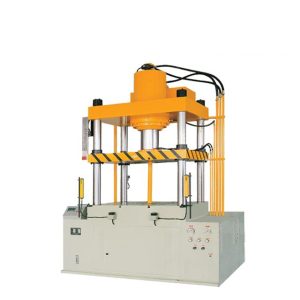Hydraulics is a technology that leverages the physical properties of fluids to exert mechanical forces in engineering, industrial, scientific, and other applications. We can see the machine which uses this technology in many factories, people use it to produce many kinds of products that we apply in our daily life, such as kitchen sinks, aluminum lunch boxes, trolleys, steel doors, etc.
Also as we know, all machines need to be maintained. Proper use of machinery and equipment, careful maintenance, and strict implementation of safe operating procedures are necessary conditions to prolong the service life of the equipment and ensure safe production.
So do you know how to maintain the hydraulic press?

Correct inspection sequence of machine parts
Inspection route: fuel tank→oil pump→filter→accumulator→valve→pipeline→oil cylinder→other accessories.
There are some tips for everyday check
Users must check all these segments before putting the machine into use.
- Whether the ambient temperature is normal, it is required to be within the range of lo~+40.C, preferably around 25.C. Whether the humidity meets the requirements, whether the ventilation and heat dissipation of the doors and windows are good; whether the air intake from the bottom of the hydraulic press, and whether the upper air outlet has accumulated dust or is blocked due to excessive dust accumulation.
- Whether the output current, voltage, frequency, and other data displayed on the display panel of the hydraulic press are normal, and whether the control knob is malfunctioning.
- Whether the display part is normal, whether the characters displayed on the display panel are clear or missing characters.
- Use a temperature measuring instrument to check whether the hydraulic press is overheated and whether there is any peculiar smell.
- Whether the fan of the hydraulic machine is running normally, whether there is any abnormal sound, whether the hot air duct is unblocked due to overheating, discoloration, peculiar smell, abnormal sound, and abnormal vibration.
- Whether there is a fault alarm display during the operation of the hydraulic press.
- Check whether the AC input voltage of the hydraulic machine exceeds the maximum value. The limit voltage of the 380V hydraulic machine is 4 (380Vx1. 1). If the external input voltage of the main circuit exceeds the limit voltage, even if the hydraulic machine is not running, it will cause damage to the transformer circuit board.
- Check whether the hydraulic press, motor, transformer, reactor, etc. are overheated and have a peculiar smell, whether the sound of the motor is normal, whether the voltage of the main circuit and control circuit of the hydraulic press is normal, whether the capacitor is partially overheated, appearance: bubbling or deformation, valve Is it broken.
- Whether the heater in the deactivated hydraulic cabinet works normally.

The hydraulic oil is also an important part to check
Hydraulic oil is the energy transmission medium when the hydraulic station is working. The quality, cleanliness, and viscosity of the hydraulic oil play a leading role in the life of the hydraulic pump, hydraulic valve, and hydraulic cylinder.
Therefore, the quality of the hydraulic oil should be highly valued when using the hydraulic station. And keep the hydraulic oil clean. The oil used in the hydraulic system must be strictly filtered, and an oil filter should be configured in the hydraulic system.
The liquid level of the oil tank should always be kept at a sufficient height so that the oil in the system has sufficient circulation and cooling conditions, and attention should be paid to keeping the oil tank, oil pipes, and other equipment clean to facilitate ate heat dissipation.
Generally, the oil temperature is 30°C-55°C as the safe temperature, which is the most suitable temperature for use, with the highest performance and the longest life. When the oil temperature exceeds 60°C, its service life will be halved for every 8°C increase.

Hydraulic oil pollution
The hydraulic oil needs not only to check but also to prevent all kinds of pollution. The pollution will damage sealing materials, coatings, and other hydraulic components. Oil stains will aggravate the wear of relative moving parts in hydraulic components, resulting in blockage of orifices or blockage of slide valve movement range, resulting in failure of the hydraulic system.
Various measures must be taken to prevent or reduce Hydraulic oil pollution, the specific measures are:
- Pipes and castings must be thoroughly cleaned before installation, and hydraulic systems must be thoroughly cleaned after assembly;
- When assembling various hydraulic components, it is forbidden to wipe with fibers (cotton yarn, etc.);
- The oil tank should be properly sealed, and the air passage should be installed with an air filter;
- The seal must be reliable, and oil-resistant seals and rubber hoses are prohibited.
- Reasonably select the filter type and installation location. The system should be equipped with coarse and essential oil filters as required. If damage is found, the oil filter should be checked regularly and replaced in time;
- Regularly change the engine oil. Generally speaking, the engine oil should be replaced after more than 10,000 hours of accumulated work; if it is used continuously, the engine oil will lose its lubricity and may be acidic, which will cause corrosion of metal parts in the hydraulic system; if it is used intermittently, the engine oil can be used every Replace every six months, or every year.



